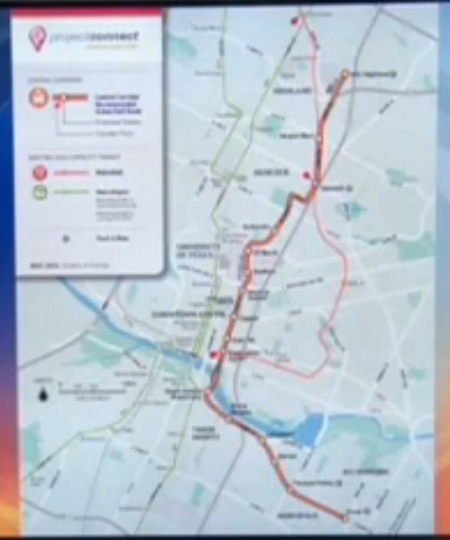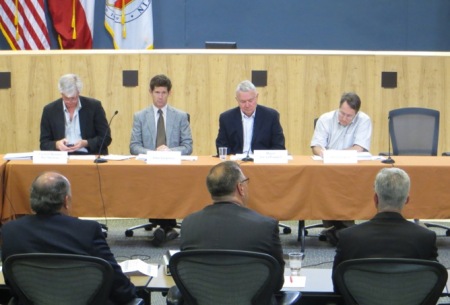
Project Connect’s urban rail plan “costs way too much to do too little”
3 May 2014
Map of Project Connect’s urban rail proposal, as shown by KEYE-TV. Despite blurry image quality, the convoluted, meandering character of the route, well to the east of central Austin and its core axis, can be seen. Screenshot: L. Henry.
♦
By Lyndon Henry
The following comments were made during Citizen Communications to Project Connect’s Central Corridor Advisory Group on 2 May 2014. At the meeting, Project Connect’s Urban Rail Lead Kyle Keahey revealed the agency’s proposal for a 9.5-mile, $1.4 billion line connecting East Riverside (southeast) with the old Highland Mall site (north).
I’m Lyndon Henry. I’m a transportation planning consultant, and am considered among the strongest rail transit advocates in Austin. Since I originally launched the notion of urban rail for this region over four decades ago, I’ve consistently made the case for urban rail as a crucial mobility alternative for Austin’s heaviest traffic, plus other benefits such as better urban development patterns.
Urban rail’s primary focus is mobility, to provide some relief for congestion – not to just enhance the value of real estate development or be a decoration for other public projects. Unfortunately, Austin’s political and civic leadership have lost this essential focus, and the result is Project Connect’s seriously misguided plan. Austin voters should reject it.
Austin voters are being asked to authorize a billion-dollar investment for this convoluted adornment for real estate interests and proposed developments — a line that bypasses the heart of the city and slowly meanders nine miles, from the East Riverside “Apartment City” area, through the backwater East Campus, up to Hancock, then through a tunnel and into the old Highland site. How many Austinites are traveling such a route? Installing a second rail line parallel to MetroRail along Airport Blvd. just squanders more money.
Furthermore, a vote for Project Connect’s plan is very likely a vote to lock out any hope of rail on Guadalupe-Lamar — our heaviest travel corridor — and lock in the MetroRapid bus replacement — so-called “BRT”. Project Connect has hundreds of millions of dollars’ worth of dedicated bus lanes and other infrastructure planned for this corridor that would block rail, possibly for decades.
By depleting available financial resources on tunnels and other lavishly expensive construction, this wasteful urban rail plan limits the more effective expansion of rail regionally. Tunnels and subway stations are options way out of scale for an urban rail starter line for Austin or virtually any city this size.
Voter rejection of this plan is the better option, because it opens the possibility for a return to planning a basic north-south rail spine along the central Guadalupe-Lamar corridor. Project Connect’s plan costs way too much to do too little, and Austin deserves better. Voters can opt for a better plan by saying No on November 4th.


It’s a sad day when some of the most experienced and thoughtful advocates for light rail in Austin are left behind, at the station, so to speak, watching what could be and should be the best opportunity the city has had in at least 14 years, if not ever, to finally take the steps it should have taken back in the 1980s to build a transit system worthy of the city’s culture, economy, geography and aspirations for the future. Instead it seems that the city’s leaders are eager to lead only in the direction that some small group seems to want to go, irrespective of the evidence that has long existed that supports the Lamar-Guad route. Now the city appears ready to risk this rare opportunity to do the right thing for most by doing something that makes sense only to some group (who?!) that is not responding to the advocates’.concerns as they forge ahead with the Mueller-Highland route that has little apparent support beyond the Project Connect in-group. Meanwhile Dallas (of all places) has been rolling forward from being one of the most auto-dependent cities in the United States to having the greatest number of light rail system miles of any city in the country! Shame on Project Connect and shame on the city council for failing the tens of thousands of people who would ride light rail through the city center if only they could, and the hundreds of thousands of people who have to breathe dirty air and endure world;-class auto traffic congestion for years just because the politicians ignore the obvious on their way to build upon their previous mistake (MetroRail). Yes, that is my mind you see that is boggling. WTF, Austin?
[…] friend and light rail expert Lyndon Henry have raised similar objections to what looks like an exceptionally expensive rail system compared to alternative Austin starter routes that don’t try to cross the river. Another […]
A great analysis and one I agree with. But so many unnecessary photos and graphics make it hard to send to people without a lot of extra trouble. And difficult to print out without using a ream of paper. Any chance of cutting out the excessive photos and then just posting the article? Every single voter and taxpayer should see this article and the sooner the better.
Steve, thanks for your interest. We’ve uploaded the original commentary as a Word document (no graphics) and created a hyperlink to it via the word “comments” in the introductory note just below the byline.
— ARN editor
..
[…] • Project Connect’s urban rail plan “costs way too much to do too little” […]